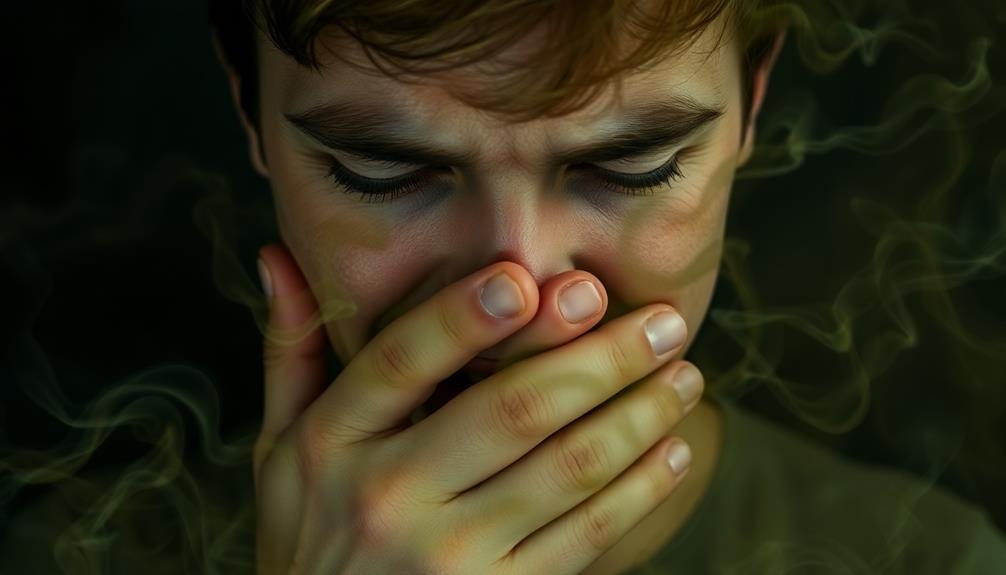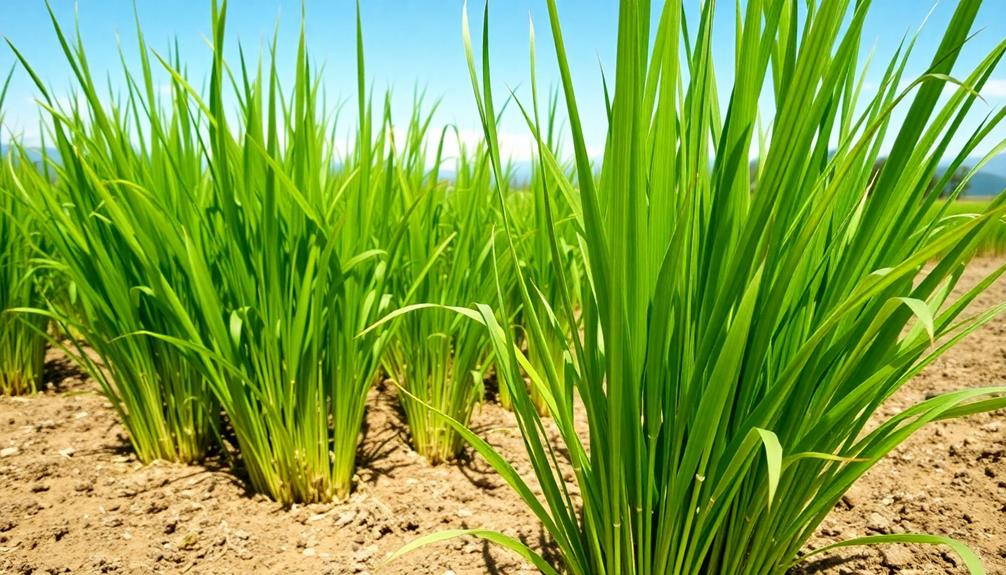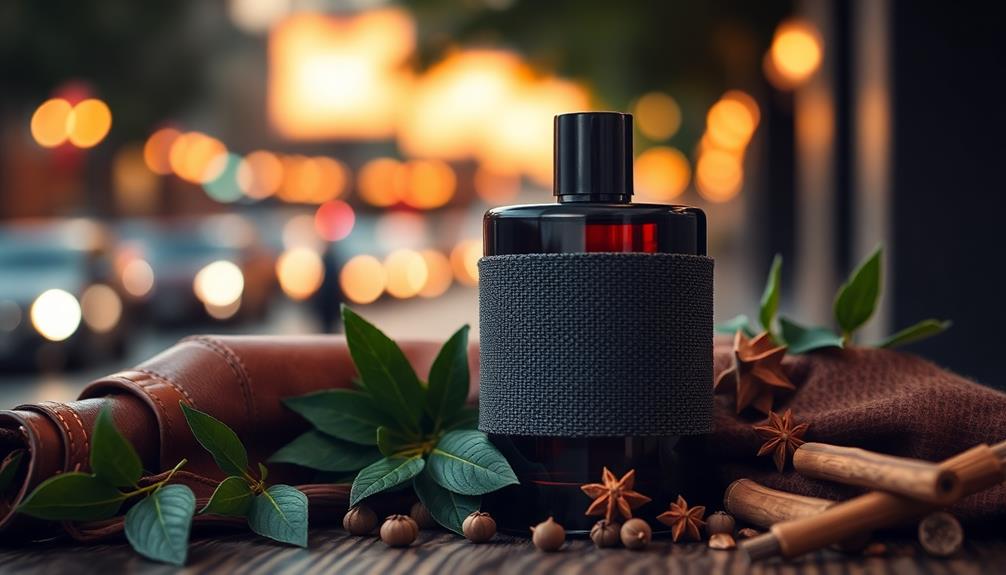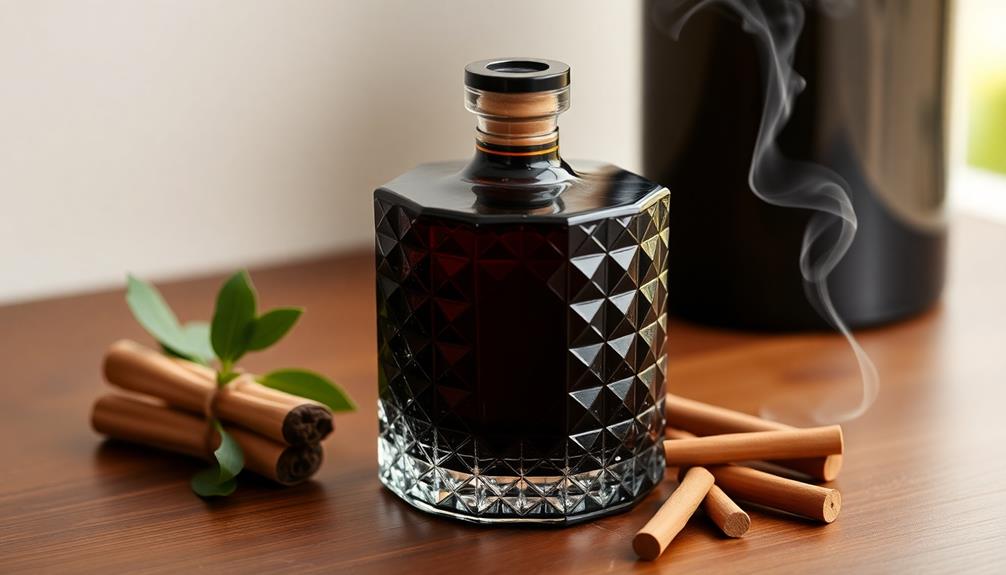Bad breath can smell different depending on what's causing it. You might notice a sweet or fruity scent, which could mean issues like diabetes. If it's sour, that might signal acid reflux. A rotten smell often hints at gum disease or tooth decay, while feces-like breath suggests serious gastrointestinal problems. Even an ammonia odor can indicate kidney issues. Food choices, dry mouth, and bacteria contribute to these smells. Don't ignore persistent bad breath, as it can point to health problems. Curious about more signs to watch for? There's plenty to discover about keeping your breath fresh!
Key Takeaways
- Bad breath can have a sweet or fruity smell, often indicating unmanaged diabetes or low-carb diets producing ketones.
- A sour odor is typically linked to gastroesophageal reflux disease (GERD) from stomach acid backing up into the mouth.
- Rotten or fetid smells are usually associated with gum disease, tooth decay, or oral infections.
- Feces-like breath suggests serious gastrointestinal issues, such as bowel obstructions, and requires immediate medical attention.
- An ammonia-like smell may indicate kidney dysfunction, particularly in cases of chronic kidney disease.
Introduction

Bad breath, known medically as halitosis, affects millions of people and can vary in odor from sweet and fruity to rotten and fecal. You mightn't realize it, but your oral health plays a key role in how your breath smells. If you're experiencing bad breath, it's important to consider what might be causing it.
For example, sweet or fruity breath may be a sign of unmanaged diabetes or a strict low-carb diet that produces acetone. On the other hand, if you notice a sour smell, it might indicate gastroesophageal reflux disease (GERD).
A rotten odor often points to poor dental health, gum disease, or infections caused by bacteria producing sulfur compounds in your mouth. If your breath smells fecal, it could signal serious gastrointestinal issues, such as bowel obstructions, which need immediate medical attention.
Lastly, an ammonia-like smell might suggest kidney dysfunction, especially in chronic kidney disease cases. Understanding these different odors can help you identify underlying health issues and improve your oral health routine.
Description of the Smell
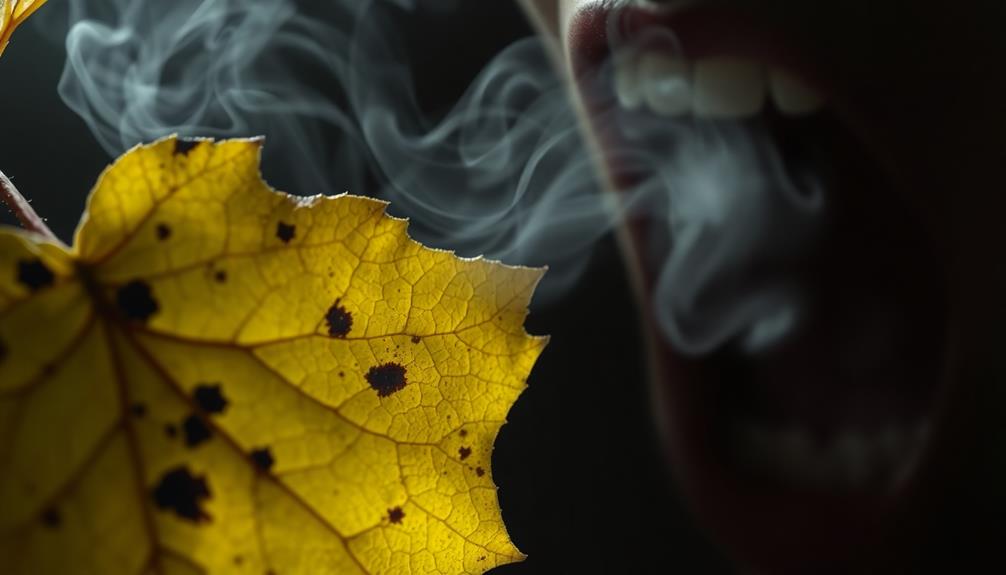
Many people mightn't realize that the smell of their breath can reveal important information about their health. Bad breath smells can vary quite a bit, and each distinct odor may point to different health conditions.
For instance, if your breath has a sweet or fruity smell, it might be a sign of diabetes or that you're on a low-carb diet producing ketones. This is known as **keto breath odor**, a common side effect when your body shifts to burning fat for energy instead of carbohydrates, leading to the production of acetone, one of the ketones responsible for the distinctive smell. Keto breath odor explained simply occurs due to the body’s natural metabolic process during ketosis, where excess ketones are excreted through your breath. In most cases, this type of breath is temporary and can be managed with better hydration or improved oral hygiene practices.
On the other hand, a rotten or fetid smell usually comes from gum disease, tooth decay, or infections in your mouth. If you notice a sour odor, it could be linked to gastroesophageal reflux disease (GERD), where stomach acids back up into your esophagus.
It's crucial to pay attention to a feces-like breath, as this can suggest serious gastrointestinal issues, like chronic bowel obstructions, which need immediate medical attention.
Source and Composition

The sources of bad breath, or halitosis, are often rooted in the bacteria that thrive in your mouth. These bacteria produce volatile sulfur compounds, which can create smells resembling rotten eggs or sulfur.
When you eat foods like garlic and onions, they release strong-smelling compounds that linger in your mouth and bloodstream, making your breath even worse.
Dry mouth is another significant player in bad breath. Saliva helps wash away food particles and bacteria, so when your mouth is dry, bacteria can multiply, leading to stronger odors.
Additionally, bad breath can sometimes signal an underlying medical condition. For instance, if your breath has a sweet or fruity smell, it might indicate diabetic ketoacidosis, a serious condition related to diabetes.
Other health issues can affect how your breath smells, too. Liver disease can give your breath a musty scent, while kidney problems may lead to an ammonia-like odor.
Typical Scenarios or Environments

Understanding the sources and composition of bad breath can help you recognize when it might be particularly problematic in certain scenarios or environments.
For instance, crowded public places can be tricky since close proximity to others makes bad breath more noticeable. You might feel self-conscious if you've just eaten something strong, like garlic or onions, as those odors linger and can really fill the air.
Morning breath is another common scenario. When you wake up, dry mouth often leads to a stronger sulfurous smell that can even smell like poop. This can be especially awkward during morning meetings or conversations with friends.
Dental appointments also provide a good chance for self-assessment. If you notice the odor while chatting with your dentist, it might be time to address your oral hygiene.
Emotional or Cultural Associations
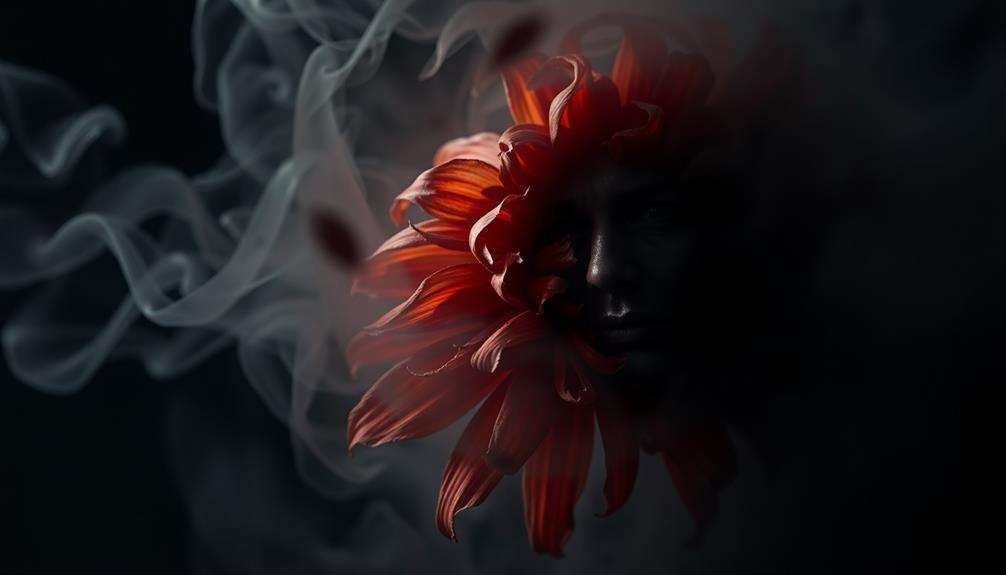
While you might think of bad breath as just a personal hygiene issue, it often carries deeper emotional and cultural implications. When someone has bad breath, it can lead to embarrassment or anxiety, which affects how they feel about themselves and interact with others.
Many cultural beliefs link certain smells, like garlic or onion, with negative qualities. This can make social situations tricky, as some people may avoid others with bad breath, thinking it reflects poor oral hygiene or carelessness.
In some cultures, bad breath can even lead to social stigmas. People may feel judged or ostracized based on their breath, impacting their self-esteem.
However, not all cultures react the same way. Some might overlook bad breath, especially within family bonds, as love and connection often take priority over minor issues.
Understanding these emotional and cultural associations can help you navigate relationships more thoughtfully. Being aware of bad breath can foster open conversations about oral hygiene.
Health or Safety Considerations
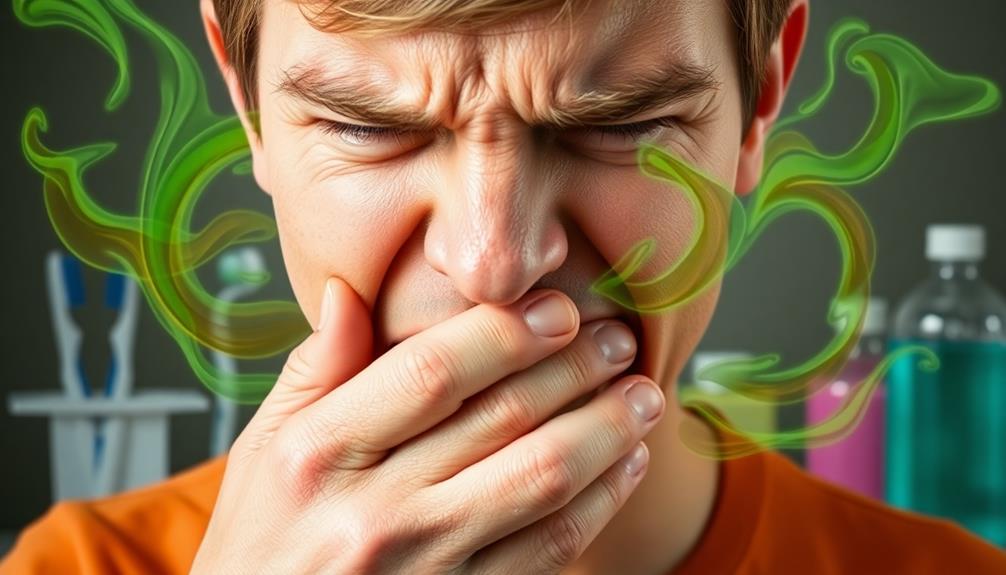
Bad breath isn't just an embarrassing social issue; it can also be a signal of underlying health problems. If you notice persistent bad breath despite good dental hygiene, it's time to pay attention.
Different odors can indicate specific health issues. For example, fruity breath might suggest unmanaged diabetes, while sour breath can be a sign of gastroesophageal reflux disease (GERD).
If your breath has a musty or ammonia-like smell, it could point to liver or kidney problems, which need medical evaluation. And if you experience feces-like breath, seek immediate medical help, as this could signal serious gastrointestinal issues.
Don't forget that smoking and tobacco use can worsen bad breath, affecting around 80% of smokers. Plus, these habits lead to dry mouth, making the problem even worse.
Regular dental check-ups are essential for keeping your mouth healthy. They help catch gum disease or tooth decay early, preventing bad breath and ensuring your overall health and safety.
Final Thoughts
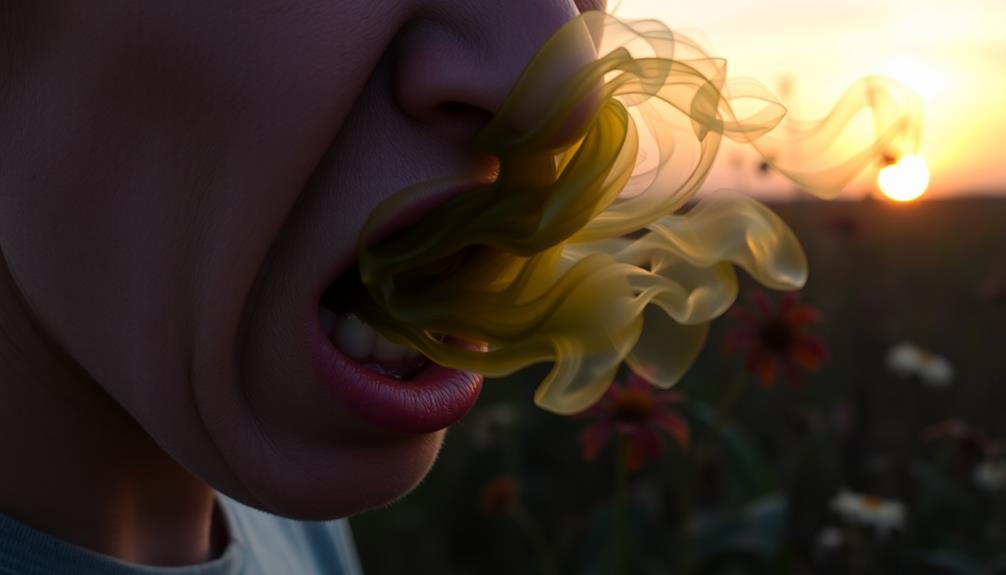
Addressing bad breath is crucial for both your social interactions and your overall health. Halitosis can be more than just an embarrassing issue; it might signal underlying health problems.
When you notice a sweet or fruity odor, it could indicate diabetes, while sour smells might hint at acid reflux (GERD). If you encounter a rotten or fetid odor, it's often linked to gum disease, tooth decay, or oral infections.
Fishy breath may suggest trimethylaminuria, a metabolic disorder, and ammonia-like smells could indicate kidney problems. Don't ignore odors resembling feces, as these may point to serious gastrointestinal issues needing immediate attention. A musty smell might even signal liver disease.
To keep your breath fresh, practice good oral hygiene. Brush your teeth twice a day, floss daily, and visit your dentist regularly. Staying hydrated helps wash away food particles and bacteria too.
If bad breath persists despite good oral care, consult a healthcare professional. Remember, understanding the reasons behind your halitosis can lead to better health choices and improved confidence.
Taking action now will help you enjoy clearer conversations and happier social interactions!
Frequently Asked Questions
How Do I Know if My Breath Smells Bad?
To know if your breath smells bad, try the sniff test by cupping your hands over your mouth and nose. You can also ask a friend or check your tongue for coating and odor.
What Does Bad Breath Smell Of?
When you encounter bad breath, it might smell sweet, rotten, sour, or even like ammonia. Each odor hints at different health issues, so pay attention and consider consulting a professional if it persists.
Can You Smell Yourself if You Have Bad Breath?
You often can't smell your own breath due to olfactory fatigue. Rely on trusted friends or dental professionals for an honest assessment, as they can detect odors you've become desensitized to over time.
Does Breath Naturally Smell Bad?
Yes, your breath can naturally smell unpleasant due to bacteria producing sulfur compounds. Factors like diet, hydration, and oral health contribute to this odor, especially after sleep or consuming strong-smelling foods. Regular hygiene helps mitigate it.
